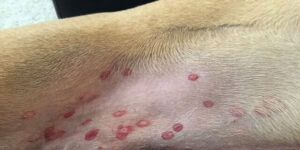“Lyme disease bright red circle on dog’s belly” is most commonly transmitted to dogs through the bite of an infected tick. The Lyme disease organism enters the bloodstream and is carried to many parts of the dog’s body, where it can localize in joints or kidneys. Lyme disease can cause a wide range of symptoms in dogs, from mild to severe.
Early detection and treatment of Lyme disease is important to prevent more serious health problems down the road. The deer tick is the most common type of tick to carry Lyme disease. These ticks are distributed throughout the Midwest and eastern United States, as well as throughout Canada with the highest proportion in Ontario.
Poor pupper has a bug bite, but you’re not sure if it’s serious. Here’s how to tell if it’s a tick bite, according to the veterinarians at Animal Humane Society (AHS). If you and Fido just went for a hike in the great outdoors, check him for bites when you get back. If he has a bite, it might be a tick.
We asked the veterinarians at Animal Humane Society (AHS) for advice on how to tell if a tick bite is serious. They say that the best way to tell if a bite is a tick bite is to look for a “bull’s-eye” rash around the bite. If you see this rash, take your dog to the vet right away.
How to tell if your dog has Lyme disease

If your dog has a flat red circle on their underbelly, groin, or ears, it is likely a black fly bite. These bites are itchy and painful, but will go away within a few days. Black flies are most commonly found in areas with less fur, so be sure to check these areas if you think your dog may have been bitten.
Lyme disease is a serious tick-borne illness that can cause a wide range of symptoms in dogs, from lameness to kidney failure. If you think your dog may have been bitten by a tick, contact your veterinarian immediately.
If a deer tick bites your dog, it may look similar to a black fly bite. One way to tell the difference is that humans will get a tick bite bullseye, but dogs will not. If you find a tick on your dog, it’s important to remove it immediately. Use a tweezers or tick removal tool to grip the tick by the head, as close to the dog’s skin as possible. Then, pull it out slowly without squishing it. After removing the tick, place it in rubbing alcohol to kill it.
Tick bite symptoms in dogs can be tricky to spot

Because they so closely resemble other, more common ailments. If you suspect your dog has been bitten by a tick, the best thing you can do is to watch out for any accompanying symptoms and contact a vet immediately. The sooner a tick is removed, the lower the chance of disease transmission is. The most common diseases caused by tick bites are Lyme disease, Rocky Mountain spotted fever, and tick paralysis. Symptoms to watch out for include:
The following are symptoms that may manifest after being bitten by a black widow spider: -Fever, lack of appetite, and depression -Swollen lymph nodes close to the bite -Heart abnormalities -Joint swelling -A stiff walk with an arched back -Sensitivity to touch -Difficulty breathing.
Lyme disease is a serious condition that can be induced by deer tick bites, and if left untreated

Can lead to kidney failure. If you’re wondering how to tell if your dog has Lyme disease, the American Humane Society (AHS) says to look out for common symptoms such as fever, lethargy, and/or sudden lameness in their legs. These symptoms can be tricky to spot because they might come and go, sometimes lasting for a day or two before reappearing a week later in the same limb or a different one. If your dog is displaying these symptoms, it’s possible that their joints are swollen, warm, or painful.
If left untreated, kidney failure can occur in dogs, especially if they start showing signs of vomiting, diarrhea, weight loss, and increased urination and thirst. If you see your pup exhibiting any of these symptoms, take him to the vet immediately to make sure he gets the treatment he wants.
Avoiding tick bites is the best way to protect your pup from these harmful parasites

Keep your furry friend healthy with year-round flea and tick preventatives, and consider using a tick-repelling spray or collar for extra protection. Regularly check your pup for ticks after spending time outdoors, and remove any that you find right away. You’re a good human!
The Animal Humane Society is a great organization dedicated to helping dogs and their families thrive together. They offer low-cost spay and neuter services, wellness exams, training, expert advice, and more. If you’re looking for ways to spend more time with your pup, they’re a great resource.

